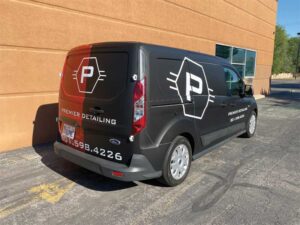
Justin Pate (pictured), an endorsed installer by The Wrap Institute, says this is the golden era for learning how to wrap cars because there are so many online instructional videos and hands-on workshops available.
However, Justin Pate, an endorsed installer by The Wrap Institute, which looks to help the vinyl wrap installation community reach higher standards of professionalism and efficiency, says, “This is the golden era for learning how to wrap a car because there are so many online instructional videos and hands-on workshops available. The Wrap Institute makes product videos for all the wrap film manufacturers, so the content directly aligns with how the specific film should be applied.
“That said, jobs are available, and there is a path for entrepreneurial types to move up the ladder—from employee to business owner. A trained and experienced wrapper can be up and running for $30,000 with a printer and a good laminator doing colour change wraps in their garage or a sublet space. We call it ‘a business in a box.’”
Selecting the right film
Vinyl wrap films from different manufacturers will have unique attributes, which may make one film easier to install or remove, more durable, or even more pleasing to the eye in terms of the colour or finish. After some trial and error, and industry word-of-mouth, most installers settle on a primary supplier whose films and digital overlaminates work best for them. Quick and easy installation is always an important consideration since labour (installation time) is roughly 90 per cent of the total cost.
As compared with colour change wrap films, the technical considerations are more extensive with fleet graphics, where one will be digitally printing on the film. That said, wrap shops should keep the following important film spec considerations in mind:
- Is a particular film compatible with one’s print and ink system?
- Will it let one print on all ink platforms: solvent, eco-solvent, ultraviolet (UV), and latex?
- Can the film accommodate different needs in terms of sizes: 1219, 1371, and 1524 mm (48, 54, and 60 in.)?
Some film suppliers have apps where one can download the right ink profile for their printer to ensure the highest print quality with the right amount of ink.
Workhorse and specialty films
As a versatile ‘workhorse,’ most wrappers will want a premium, high gloss, cast film with superior 3D conformability, excellent printability, and maximum durability for complex surfaces with curves and recesses. It should pair with a wide variety of digital overlaminates and work well for other standard applications (like walls) in addition to fleet graphics.
Wrappers should look for films with an adhesive that allows the material to not only slide easily across the surface, but also readily pulls apart if it folds on itself and allows installers to eliminate bubbles with a simple press of their finger.
In addition to this ‘workhorse’ film, one should also familiarize themselves with the more specialized films in a manufacturer’s line that may be better suited for certain surfaces. For example, these other films might include:
- A thicker film series best suited for flat to moderate curved installs like box trucks and trailers (with or without rivets), or car wraps but not for door handles and mirrors.
- A thinner film series suited for more contoured vehicles, or for semi-trailers with rivets and corrugations.
- An optically clear gloss film that can be used on window perforation, as well as on painted body surfaces.
- An extra conformable series designed for extreme compound curves such as on helmets and motorcycles, as well as deep recessed areas found on some commercial vans.
These specialized films may also give one the option of matte or satin finishes in addition to standard gloss.

Two-faced wraps remain popular for vehicle graphics due to the added visual impact when parked and on the road. Here, vehicle wraps and graphics shop Vinyl Wurx used satin black and Gloss red wrapping film to create the two-tone effect. The logo and vehicle lettering were completed using a gloss white film.
Do not forget the overlaminate
To enhance the way the colour pops, along with the durability of fleet graphics films, using them in combination with an overlaminate is always recommended. Most installers have a preferred all-purpose overlaminate but will also stock one or more specialty products.
The overlaminate protects against colour fade from the sun and UV light. Other options might include a laminate that is great for box trucks and trailers, and another that is super conformable and ideal if a shop is doing a lot of vans. As with the vinyl wrap films, most wrappers will want an overlaminate that installs quickly and easily with a minimum stress level.
Ensuring a satisfied customer
As successful business owners know, it is not always enough to do a great job. It is equally important not to overpromise and, yes, to overcommunicate. One should not assume the consumer knows what they need to do (or not do) after their purchase. The following are some basic guidelines one should share with their customers:
- Wash the wrapped vehicle on a regular basis;
- Use approved aftercare products for wraps;
- Avoid using waxes and cleaning products with alcohol—they can burn the lamination which will result in premature fading;
- Matte finishes require more care and maintenance than gloss finishes; and
- When it comes time to remove the film, it should always be done within the warranty period. When removing a wrap, the temperature of the substrate should be above 15.5 C
(60 F) for best results.
Lastly, wrappers should be sure to take full advantage of all the resources offered by their distributor, film manufacturer, and industry associations.
Joey Heiob is a technical service representative at Avery Dennison Graphic Solutions covering the eastern U.S. and Canada. He has 19 years of experience at the company, including the last 11 in technical service. For more information, visit graphics.averydennison.com.





